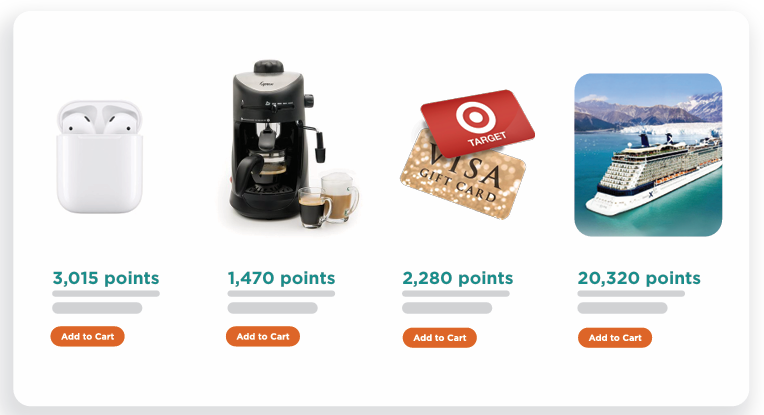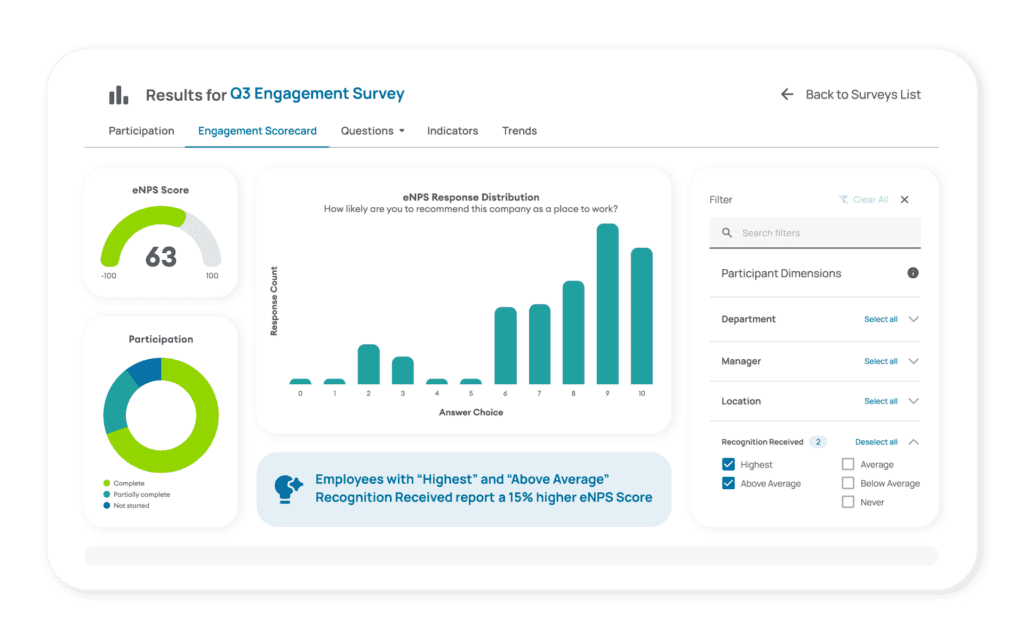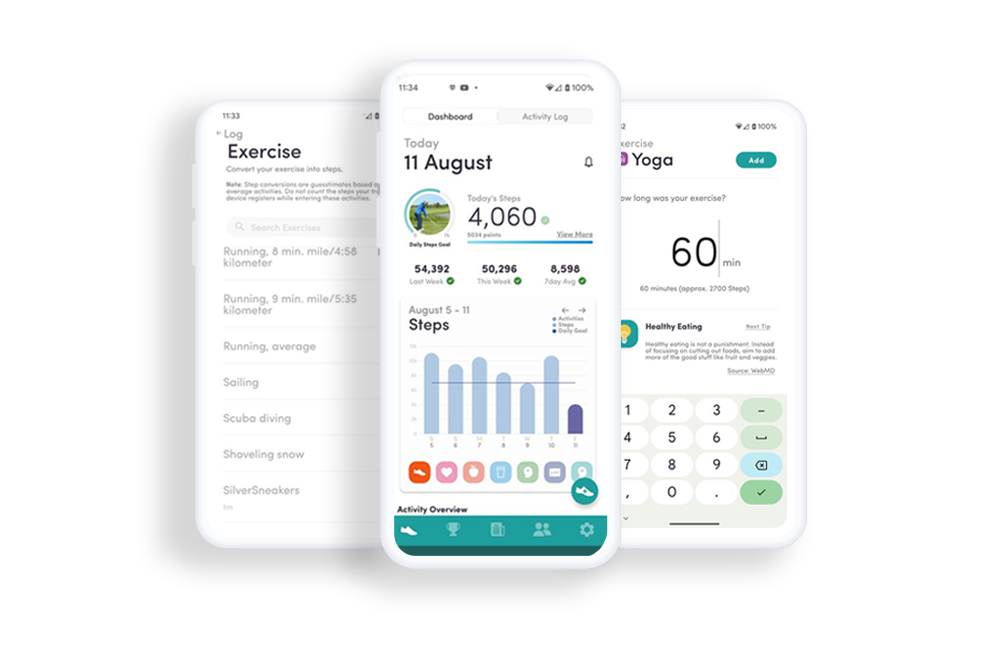November 21, 2025

Many companies think building employee loyalty is simply about offering more rewards, adding new perks, or introducing flexible schedules. While those things do matter, what often gets overlooked are the everyday experiences that impact how people feel about their work: being recognized, valued, and supported to grow.
Studies show that employees who receive recognition and feel consistently appreciated are 45% less likely to leave the organization after two years. Encouraging employees to learn new skills has a similar impact, as those who strongly agree their organization supports skill development are 47% less likely to be searching for another job.
To effectively build employee loyalty and see similar results, organizations need to:
- Build a culture of everyday recognition. Loyalty begins when appreciation becomes a habit, not an occasional gesture. Consistent recognition builds trust, strengthens relationships, and reinforces shared values across teams.
- Value progress and longevity equally. Employees want to know that their daily contributions and long-term commitment are both appreciated. Recognizing effort and achievement together shows that loyalty and performance are equally important.
- Create meaningful, individualized experiences. People are motivated by different things. Personalizing how you reward, develop, and engage employees helps each person feel valued in a way that resonates with them.
- Listen intentionally and act on feedback. Collecting feedback is only the first step. When organizations take visible action on what employees share, it strengthens trust and signals that every voice matters.
- Support well-being as part of your culture. A loyal workforce is one that feels balanced and supported. Prioritizing wellness, flexibility, and psychological safety helps employees bring their best selves to work and stay committed long term.
We created this guide to help you foster employee loyalty the right way, beyond surface-level engagement tactics. You’ll learn what employee loyalty actually is, why it’s so important for long-term retention, and the steps you can take to build it within your organization. Within these key principles, we'll share real-world examples from the Terryberry platform.
What Employee Loyalty Actually Means (and Doesn’t)
Depending on who you ask, you might see employee loyalty defined as how long someone stays with a company or how satisfied they are with their job.
However, loyalty goes far beyond tenure or happiness. It’s not just about staying in a job for the paycheck or enjoying a few perks.
While pay, rewards, and benefits play an important role in retention, they don’t fully explain why people choose to stay committed over the long term. Employee loyalty is built through trust, recognition, and a sense of shared purpose.
That's why many people confuse employee satisfaction with loyalty. It measures employees' satisfaction with their current situation. But satisfied employees can still leave if they don’t feel valued or see a future with the organization.
So, what exactly is employee loyalty?
It can be defined as the emotional commitment and trust employees feel toward their company.
There tends to be a belief that their contributions matter and their growth is genuinely supported. Loyal employees stay not because they have to, but because they want to.
5 Steps to Building Employee Loyalty That Lasts
Many organizations assume that loyalty automatically follows when employees are satisfied and well-compensated. But months later, they realize turnover hasn’t improved, largely because they’re not addressing the real reasons people choose to stay.
Typically, companies that retain their best people don’t rely solely on perks or pay increases. Instead, they make recognition habitual, reward meaningfully, celebrate milestones, listen continuously, and prioritize employee well-being.
The following five steps outline how to turn those ideas into practice using an integrated approach that connects recognition, rewards, analytics, and wellness into one continuous system.
1. Centralize Every Form of Recognition
Many organizations want to build loyalty through recognition, but their efforts are often scattered across multiple tools and teams. The typical recognition might look like managers sending thank-you emails, peers shouting each other out in chat threads, or HR tracking anniversaries in spreadsheets.
The intention behind this approach is good, but the experience is usually poor for employees because they may never see others being recognized. Or worse, they might feel like their own contributions go unnoticed.
Employee loyalty relies on visibility and consistency. Employees want to see appreciation happening across the organization, not just in their department or between certain teams.
That’s why a centralized approach to recognition matters. When appreciation is visible to everyone, it reinforces shared values and strengthens cultural alignment.
Terryberry’s Social Recognition Platform helps organizations solve this by bringing all forms of recognition, including peer-to-peer, manager-driven, milestone, and performance-based, into a single shared platform.
The feed acts like a company-wide “recognition wall,” where employees can give shoutouts, react to posts, and celebrate wins in real time. It turns recognition into a living, visible part of daily culture.
Plus, Terryberry can automate most of what companies often forget. Managers receive reminders to celebrate milestones, employees can recognize peers instantly, and award nominations automatically route for approval. This means recognition no longer depends on setting reminders or someone remembering. It just happens naturally every day.
Research shows that employees are 2.7x more likely to be highly engaged when they believe they’ll be recognized for their work. Companies that use a formal recognition platform also experience 31% lower voluntary turnover and are 12x more likely to achieve strong business outcomes.
2. Personalize Rewards to Fit Individual Motivations
Most companies are aware of employee rewards and their impact on motivation and loyalty. The problem is that some organizations get it wrong, which usually leads to lower employee participation and a wasted investment by management.
The approach they take is often too transactional. Employees are given gift cards, company swag, or team lunches under the assumption that everybody will feel valued the same.
Terryberry’s Employee Reward Platform helps companies build that connection through a points-based rewards system tied to real recognition moments. When employees receive praise, they earn points that can be redeemed through a global online rewards catalog.
This gives every employee the freedom to choose what’s most meaningful to them, whether that’s new tech, travel experiences, wellness products, or charitable donations.
Rewards are instantly redeemable and available in 70 languages and multiple currencies. This makes it easier for global organizations to offer consistent, equitable recognition experiences across all regions. All rewards can be distributed automatically, so there are no delays, manual processing, or forgotten follow-ups.
In our experience working with thousands of organizations worldwide, giving employees choice and control over their rewards consistently leads to higher engagement and stronger loyalty. When people can choose something that genuinely resonates with them, recognition feels more like a memorable experience than just a token gesture.
For example, an employee who earns points for hitting a significant project milestone might choose to redeem them for a weekend getaway, a donation to a local animal shelter, or a new set of noise-canceling headphones.
Because the reward connects to their personal interests and values (and not just their performance), it feels more meaningful.
3. Automate Milestones and Celebrate Tenure Consistently
Most companies have good intentions when it comes to milestone and anniversary recognition, but managing the process manually often leads to mistakes, missed dates, or delayed acknowledgments. When someone reaches a career milestone and the celebration arrives weeks later (or not at all), the message sent is that loyalty and tenure might not matter.
Automating part of the process solves these issues. Terryberry’s Employee Service Awards allow organizations to track, recognize, and reward career milestones automatically. This could be anything from onboarding anniversaries and certifications to long-service awards and retirements.
Here’s how you can build this step into your loyalty strategy:
- Define all meaningful milestones up front. Decide which dates matter: 1-year, 5-year, 10-year, safety certifications, promotions, etc. Then enter these into the system so each event is automatically tracked.
- Set recognition triggers. On the platform, set reminders and automated workflows so that when a milestone approaches, notifications go out to the employee, their manager, and the team. This ensures recognition isn’t left to chance.
- Customize the acknowledgment. Use the platform to require or allow peer/team contributions, such as thank-you messages, photos, video messages, and comments. For example, Terryberry’s “Be Celebrated” feature invites the team to submit congratulatory notes before the actual date.
- Monitor and analyze milestone participation. The system tracks how many milestones were recognized, how many were missed, and which teams participate most. These analytics help HR identify recognition gaps and reinforce a culture of appreciation.
When you automate milestone recognition, you can ensure every employee feels seen and appreciated at the right moment. This creates internal consistency, builds trust, and reinforces the message that loyalty is both recognized and rewarded.
4. Listen to Employees and Measure What Matters
A common practice among many organizations is to use annual surveys or exit interviews to measure employee engagement. But by the time that data surfaces, the most valuable feedback has already walked out the door. Building loyalty means creating an ongoing feedback loop where employees feel heard and leaders can act on insights in real-time.
Terryberry makes this possible through its Employee Engagement Surveys and Analytics tools. The platform helps organizations gather, analyze, and act on employee sentiment across every stage of the employee lifecycle.
Instead of waiting for yearly engagement scores, you can send pulse surveys, collect anonymous feedback, and visualize data on recognition, participation, well-being, and belonging all in one place.
Each survey can be customized to match your company’s culture or current initiatives. Terryberry’s tools make it easy to focus on what matters most to your workforce, so you can measure recognition effectiveness, manager support, and employee sense of purpose.
Our software also includes automated reminders that help increase response rates, while dashboards turn responses into actionable insights.
However, teams can unlock the full value of this data by connecting feedback to real recognition activities. For instance, you can compare engagement levels between teams that actively participate in recognition programs and those that don’t. This can reveal how recognition frequency correlates with loyalty, morale, and retention.
5. Reinforce a Culture of Well-Being and Belonging
Even the best recognition and reward programs fall short if employees don’t feel cared for as people. Organizations with the highest levels of loyalty consistently invest in employee well-being by building a culture that supports growth, trust, and meaningful work.
Terryberry helps companies do this through its Wellness and Engagement Platform, which encourages holistic well-being through team-based challenges, personal progress tracking, and community engagement.
The platform supports everything from step-count and hydration challenges to mindfulness initiatives and nutrition tracking. This all promotes healthy competition and accountability in a positive way.
For example, a company could launch a month-long step challenge in which employees join virtual teams and track their daily steps toward a shared goal (such as collectively walking 10 million steps or completing an “around the world” route).
Similarly, management could opt for a hydration or mindfulness challenge, where employees log daily habits, earn points for consistency, and encourage each other along the way.
These challenges bring people together across departments and locations, help employees connect through shared goals, and improve their physical and mental well-being.
Because it integrates with Terryberry’s broader recognition system, employees can earn points for completing wellness goals, cheer on teammates, and see their efforts celebrated publicly.
This visibility turns health and wellness from an individual task into a shared company experience. Leaders can also track participation and outcomes through built-in analytics to identify how wellness engagement connects to morale, recognition frequency, and retention.
Build a Loyalty-Focused Culture with Terryberry
Take your employee loyalty beyond surface-level perks and one-off recognition events with Terryberry’s fully integrated employee engagement platform.
Gather meaningful insights through science-backed surveys, track recognition and wellness participation, and measure the impact on loyalty and retention. Our platform connects recognition, rewards, wellness, and survey feedback so you can turn insights into tangible improvements in employee experience.
Schedule a demo today to see how Terryberry can help you foster a culture where employees feel valued, supported, and motivated to stay long term.






